How To Write Better Titles and Taglines For WordPress

There are over a billion websites online, with more launching every day. If you are new to building and managing a website, you may be overwhelmed by that amount of competition. How do you make your site stand out, and attract your share of the traffic?
The first step in getting noticed is to have an eye-catching title and creative tagline. Since these are the first elements your readers will see, you want to make an immediate impact. Having a title and tagline that focus on your purpose and brand gives you an advantage over other sites competing for the same audience’s attention.
In this post, we’re going to explore what WordPress titles and taglines are and how they affect your website. We’ll also discuss how to create a title and tagline that define your brand and are optimized for search engines. Let’s get started!
What Are WordPress Titles and Taglines?

Your site’s title and tagline are usually the first thing visitors will see. It gives you the name of the blog and says exactly what you’ll find when you visit the site – concise, accurate and professional.
As you can probably guess, your title is the name of your site. It’s how people identify your brand and how they search for you online. On the other hand, your tagline is a short statement similar to a subtitle or advertising slogan, often placed right underneath your title. It works as a brief description of what your site is about and why it exists.
Combining a strong title with a clear, descriptive tagline gives your site an advantage when trying to capture audience attention. Take another look at our own title and tagline combination above. It provides the name of the site, while also clearly and concisely explaining what you can expect from our content (themes, plugins, and guides).
It may take time to come up with a well-crafted title and tagline, but it is definitely worth the effort. These two simple pieces of text can help you stand out from similar sites. They also tell your readers what your site is about, as well as the tone and style to expect. Best of all, when done correctly, you can use your title and tagline to improve your WordPress Search Engine Optimization (SEO).
How to Create Better Titles and Taglines for WordPress
When deciding how to brand your site, you should start by coming up with an appropriate title. Once you have your title ready, you can create a tagline that complements it, and then optimize both elements for SEO purposes. Let’s talk about how to get these tasks done.
Step 1: Choose Your Website Title
Coming up with a website title can be scary, because it will be the first impression that customers get of your site. Think about it this way: your title is your brand. It’s how people recognize you among all the other sites out there.
The key to coming up with a strong title is understanding what the goals of your site are. Is it a personal blog? Or maybe you are starting an e-commerce store, a nonprofit organization, or an online portfolio. Either way, it’s easier to find a title if you are clear about your site’s purpose.
Need Help Finding a Website Name?
When you know what your site is about, it’s easier to come up with possible names. But if you’re still finding it difficult, try these:
- Use adjectives or phrases that describe you, or words or phrases that describe what you do. For example, let’s say you have a do-it-yourself blog about a variety of things you’re good at doing and can help people with. You could call your blog “Jack (or Jill, or your name) of All Trades”.
- Deliberately misspell or invent words that are related to who you are or what you do. Do you provide case-based dictionary and thesaurus help? Call your site “Dictosaurus”. Get creative!
- Try using a word generator or a thesaurus for new ideas.
Keep your website’s purpose in mind. It’s fine to use something fun and crazy for a personal blog, but you should have something at least understandable (and a little professional) for a business website.
If your website is your online portfolio or a means of promoting your freelancing business, a good option is using your own name for the title – for example, yourname.com. This might strike you as too forward, but it will tell people who you are without them needing to dig into your profile at all. This enables you to build yourself and your authority as a brand. Neil Patel, for example, has positioned himself as an online marketing guru by branding his name:

Step 2: Create a Good Tagline
Taglines can be tougher to create than titles. You want to make sure yours sums up your site. If you can find a clever way to do that using a play on words or alliteration, that’s fine. However, concisely describing your site’s content will be better than a clever pun that doesn’t tell readers what to expect. So even though your tagline will be displayed after your title it just as, if not more, important since taglines:
- Provide context for your title, if it doesn’t already clearly indicate what you do.
- Emphasize or draw attention to the purpose of your site.
- Set the tone for your site.
- Contain keywords that will help your site show up in searches.
You could have the coolest title in the world – say, for example, Shiny Betrayed Dinosaur – but without a tagline, people aren’t going to know that your site is a personal travel blog about your experiences exploring new and exciting places.
Your tagline is what’s known in marketing as a unique selling proposition. It’s how you can show visitors what the benefit of checking out your site will be, answering the question of what’s in it for them. If they don’t know why your site is here, or how it’s relevant to them, chances are they won’t visit.
What’s the style of your website content? Do you have witty statements and punchy humor? Are you showing off your skills as a designer or technician? Are you upbeat, sarcastic, matter-of-fact? Let that show in the tagline – visitors will get a taste of what they’re in for.
Coming Up With a Good Tagline
A good tagline will not only draw visitors in, but also help them remember you. The best taglines have the following traits:
- Keep it short: No matter how you come up with it, we recommend that you keep your tagline short. You want to make the maximum impact right away, and a long, rambling tagline won’t fully display in search results. Try not to use more than 60 characters, because that’s what will be displayed in the search results. Being concise is more effective than being long and rambling.
- Don’t repeat: They add strength to the title without repeating it. Remember, you’re providing context for your site’s title, elaborating on the purpose and goals of your site.
- Be different and catchy: You want to say something about yourself that other bloggers or business people aren’t saying. To stand out spend time researching the competition. If your tagline can express what others aren’t already saying, or phrase something in a new and unique way, your voice and brand will be more memorable.
It’s also helpful to figure out who your target audience is. What kind of readers are you hoping to attract? What benefit do you want to provide them with? This will help you come up with a tagline that stands out in a search. Need a bit more help? Try Shopify’s free slogan maker to get started.
Why Is a Good Title and Tagline So Important?

As we mentioned earlier, there is a lot of competition on the internet. The last few years have seen an exponential increase in the sheer amount of content available online. According to a 2014 infographic from Uberflip, every day there are nearly 145 billion emails sent, 2.73 million blog posts published and 500 million tweets – not to mention all the hours of video uploaded to YouTube or news articles published. Imagine how much that has increased in the last year!
With so many people creating and marketing so much content, getting people to care about your content has gotten a lot harder. Having a title and tagline that catch readers’ attention and are relevant to your site will help you draw more visitors and stand out from the crowd.
Search Engine Optimization
To help you hold your own among the competition, consider Search Engine Optimization (SEO) – that is, using particular keywords to ensure your site shows up high on the list of search results in order to get as many visitors as possible. While you shouldn’t rely only on search engines to generate site traffic, they are still a useful tool.
Search engines look for keywords, so having relevant content with appropriate tags will help – but making your title and/or tagline SEO ready will yield better results. Titles generally function as the brand name and don’t always have room for keywords, so most SEO will happen in your tagline – make sure they’re relevant and your tagline still makes sense!
How To Add An SEO Friendly Title & Tagline to WordPress
There is a long-standing debate over whether it’s more important for titles to be clear or clever. When it comes to your website, the deciding factor should be its impact on SEO. Along with providing context and setting the tone for your site, titles and taglines enable you to use keywords to boost your search rankings. Lucky for your, there are multiple ways to add SEO friendly titles and taglines to your website.
Option 1: Use WordPress’ Built-in Title & Tagline
WordPress includes built-in options for your website title and tagline. In fact, you should have chosen your site title when you first installed WordPress. To make changes or to add a custom tagline, simply log into your WordPress dashboard and navigate to Settings > General:

Or you can click on Appearance > Customize to go to the live theme customizer. In our Chic blogging WordPress theme, the site title and tagline are the very first customization option.
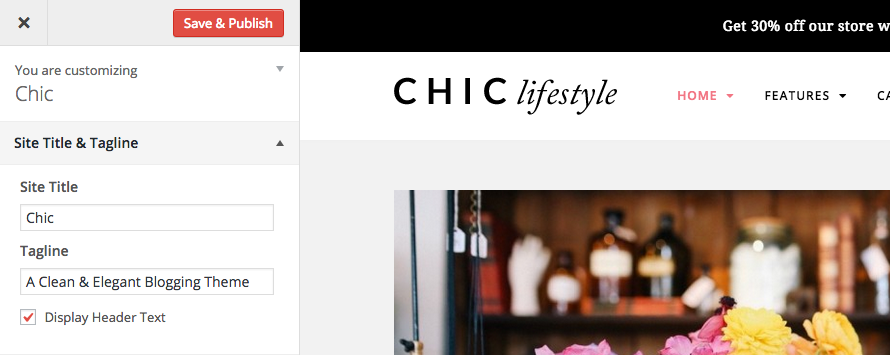
In Chic (and other premium WordPress themes) the tagline might be hidden by default, so you’ll probably have to enable a setting if you want to display it. For Chic, the option is right in the customizer General Theme Settings section under Header options. Just check the box and click save.
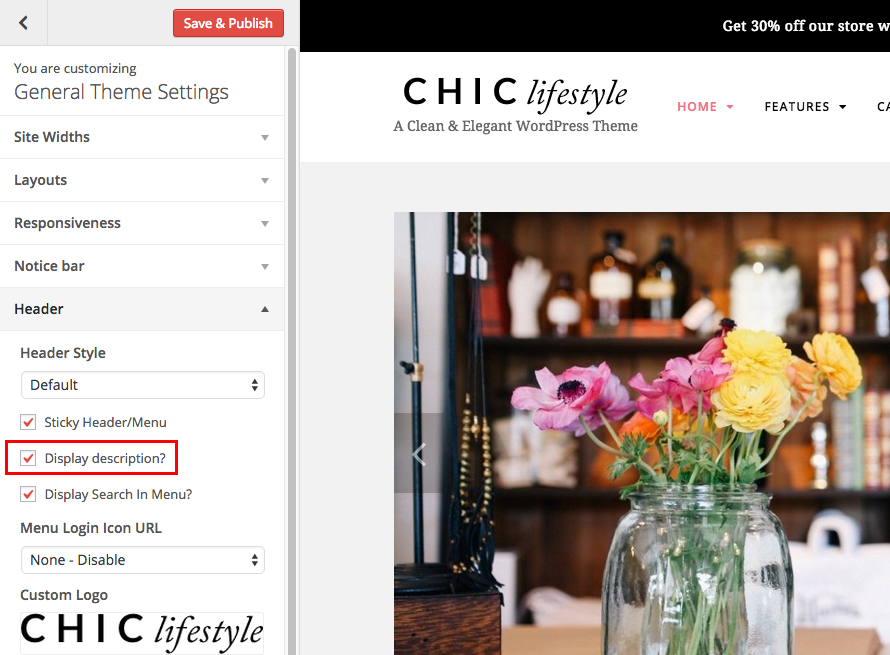
Option 2: Use a WordPress SEO Plugin
But these titles often aren’t the best option, since the default title and tagline will apply to your entire site. To really improve your SEO you’ll want to enlist the help of a plugin. We personally use and recommend the Yoast SEO Plugin, which you can get for free from the WordPress plugin repository.
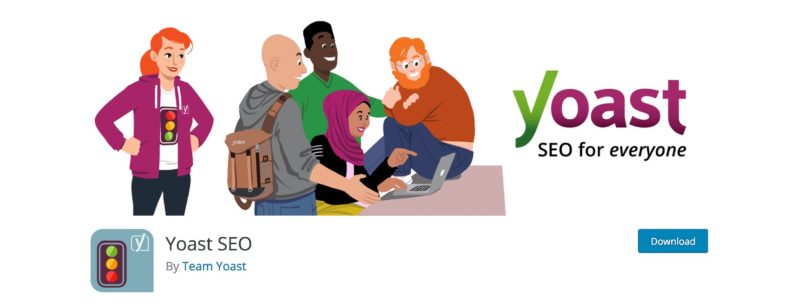
Once installed, hover over the new SEO menu item in your WordPress dashboard, and then click on Titles & Meta. From here you can add better default SEO-friendly titles and taglines to the various sections of your website – including the homepage, custom post types (this applies if you WordPress theme includes portfolios, testimonials, staff, events etc.), taxonomies (that’s your categories, tags and more), archives and miscellaneous pages (this would usually be your 404 and search results).
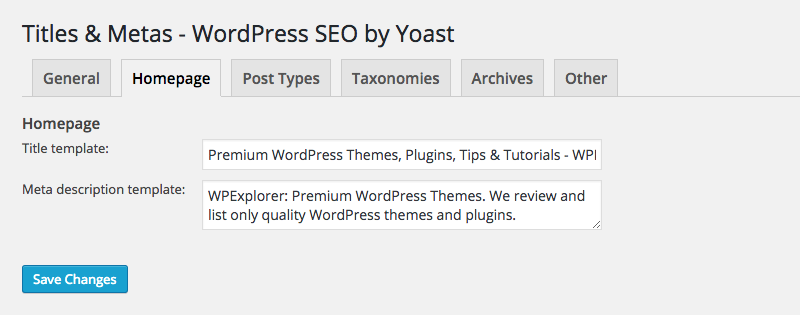
WordPress SEO by Yoast includes tons of variables to make automizing your titles and meta descriptions (which are like taglines for all your pages and posts) easy. This is a must have feature, since you likely won’t want all of your blog category pages to share the same title and tagline description. Here’s an example of how we format our blog post titles on WPExplorer:
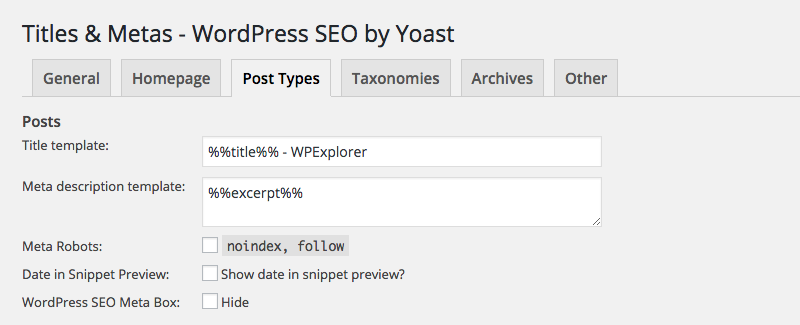
We’ve setup our blog posts to use the %%title%% variable followed by our website name by default. But, Yoast also has individual per page and per post options to override the defaults you’ve chosen above. To change your title or meta description format, just open your page or post and scroll down below the content. You should see a WordPress SEO settings box like this:
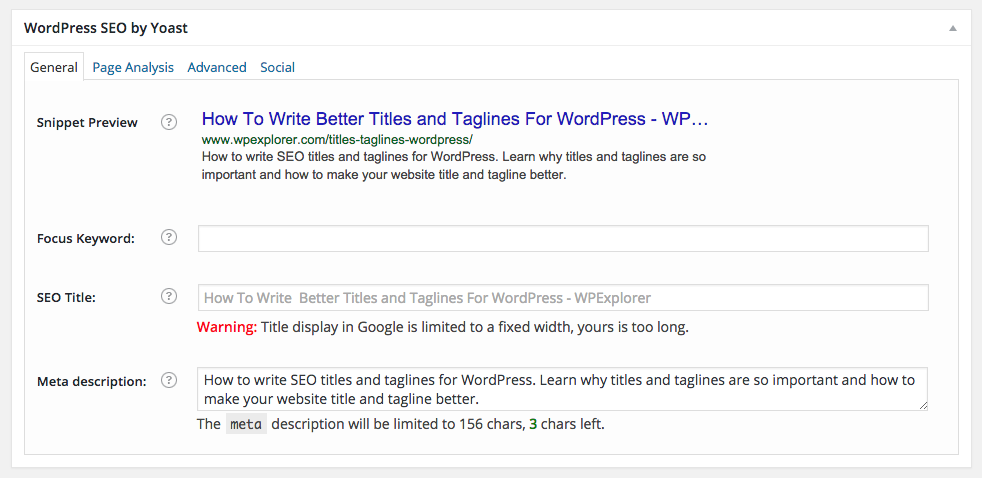
From here you can check general SEO (see if your desired keywords are found enough in your page or post, run a page analysis, etc.), but you can also see if your default SEO title is working, and you can add a custom meta description as well. If you look in the picture above, you can see out title is actually a bit too long so we should probably add a custom one, and we’ve already added in a custom meta instead of using the default (which would have been the first 156 characters of the post, since we set the metas to %%excerpt%%).
WordPress SEO by Yoast has tons of other great SEO features, and if you really want to learn more you should checkout their knowledgebase. There are detailed instructions on how to use all of the other SEO options!
Conclusion
Having a good title and tagline for your website is necessary to set yourself apart from the crowd and drive traffic to your site. With the tips we’ve given you above, coming up with your title and tagline doesn’t have to be scary. In fact, it could turn into a lot of fun! Do you have a title or tagline that you’re particularly proud of? Let’s hear it – post in the comments section below!


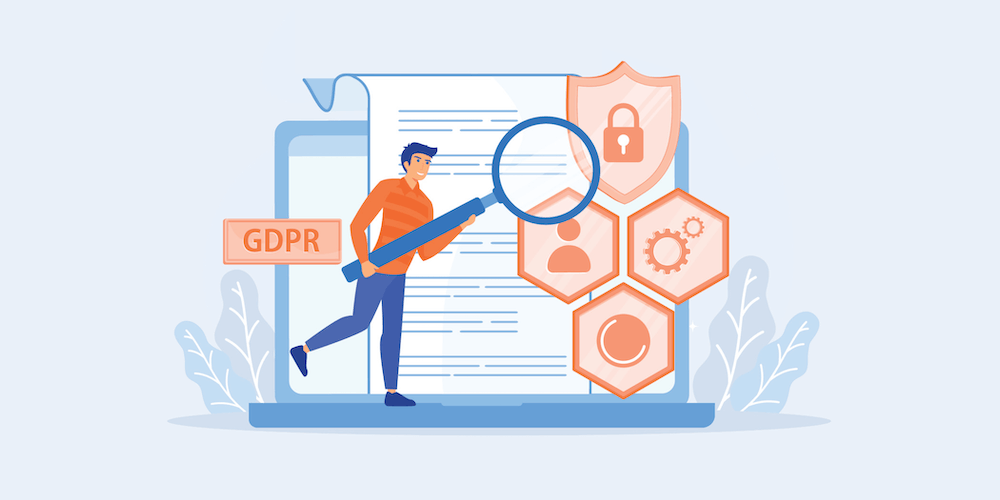

Helpful post for the beginners and very informative as it is explained very precisely. Thanks!!
I do like the article. But, I noticed it says to get plugins you have to be a Business plan. Is that true, I thought Premium plans could too?
Hmmm – I’m not sure which plugin you’re referring to? We only mention Yoast SEO which includes the titles and taglines options in free version of their plugin so there’s no need to upgrade unless you want to support them (or have access to other advanced SEO options)
Hello Tom, Thank you for this nice information. 🙂
Thank you so much for the useful info.
Very helpful!
Really useful
Very informative. For a first time user I understood everything you said and how to go about it. Thank you for your help.
This is gold, thank you for sharing it. My primary business is not blogging but I try to leverage my blog to drive that business and tips like these are not things I’d ordinarily know.
Thank you for this, very helpful!
Very helpful. Thanks for the infos.
Thank you so much for this information guide, I am new to WordPress so this is a god send for me; I am skimming my way through the information. It’s all very overwhelming being new to blogging but I’m sure I’ll be off to a fighting start soon. Very insightful information. Thank you
I think tag lines today are more about creativity. Drawing attention to your site is the main purpose behind a tag line. This makes is difficult to include keywords in it as well. Keywords drives out the creativity. I faced this when I was coming up with my blog’s tagline (WPblog). I finalized “Your ultimate WordPress pit-stop” that had nothing to do with keywords.
Thank you. It was very helpful
Very helpful – thanks! I’d already decided on my title and tagline before I read it, but I think I’ve done quite well with what I’d decided on: Title: Footeloose (my surname is Foote!) and Tagline: A travel blog – follow my Footeprints!
I love it! 🙂
A great article, for beginners and experienced users too. Well written and I have learnt more about the titles and why it’s so good for SEO. Thanks for sharing.
Does the Title and Tagline run together in (1) line, or does the Tagline show up under the Title when people do a Google search? Because there is already info about my business under the Title like most website searches, you know what I mean? Where exactly would the Tagline show up? I think I asked that twice, sorry. Very new at maintaining my website with WordPress for the first time. Any help from anyone would be appreciated!!
The Title and Tagline are most commonly seen on your homepage. Placement will depend on your WordPress theme. Some themes put the tagline right under the title, some have no tagline support, and other will put them next to each other (perhaps with a separator).
Well-written. Combines important aspects of a site into a comprehensive whole.
Thanks for this blog, you provide the best information for all.
Very useful information for improving my post title. Thanks for this.
Awesome information for optimizing titles. thanks for sharing your tips with us.
Very informative and helpful post. I used your guide to improve my titles to try and help my seo.
That is actually great and useful information for any site owner. Titles and taglines are so important and should not be overlooked.
Thanks for all that valuable information!! I just want to say your article is very helpful, that’s very clear.
That’s very comprehensive and educative. I have now decide my tagline as “lessons from entertainment”.Thanks once more
That sounds like a great tagline!
A trail runner for the past few years I wanted to help others discover and enjoy local trail runs on their “doorstep”
So I’ve started this Blog in response to the positive feedback I received on Facebook to the route review and guides I shared, produced whilst running routes I designed.
Your article helped me understand the difference between Site Title and Tagline and especially helped me define my tagline to contain all the relevant keywords in under 60 characters yet help the visitor understand what the site could provide for them.
Thank you 🙂
PJ
I’m so glad we could help!
Does it hurt anything or break any links to CHANGE your title (not the URL) and tagline for your website?
Changing your titles or taglines will not effect your links – so feel free to make tweaks to optimize your site!
I am really enjoying reading your post. Your guide will hep me with titles and such. I have bookmarked it and I am looking forward to reading new articles. Thanks for this content.